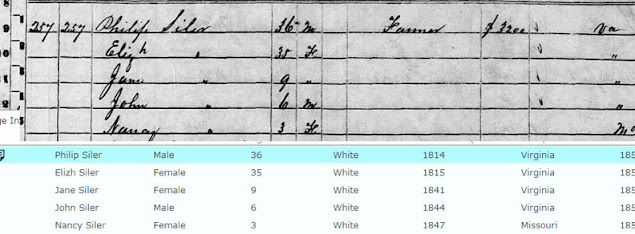I bought this quilt decades ago at a flea market in Platte County, Missouri. The seller told me it had been made in Virginia and brought to Missouri.
The name inked on the reverse was unusual enough that I could learn something about her, finding she immigrated from Berkeley County with her husband Philip Siler.
Now years later with today's terrific genealogy resources I can find out much about the maker, Elizabeth Robinson Siler born in Berkeley County in 1815 or so. She married neighbor Philip Siler in 1840 when they were in their twenties. They apparently lived in a small community called Tomahawk between Martinsburg and Berkeley Springs.
Tomahawk and Berkeley County are now in West Virginia but before 1863 the area was in the northern part of the state of Virginia. In 1846 the Silers took their two young children John William and Jane Rebecca to western Missouri, accompanied by Philip's brother Elias, his wife and children.
They settled about ten miles north of Weston, a thriving Missouri River town.
The Silers settled in Marshall township in a hilly area not far from the Missouri River and east of the boundary to what was Indian Territory in the 1840s. The hills are rather remarkable for the Kansas City area--- a place often considered flat by the uninformed.
Religion may have been a motive for migration. Philip was described in the Platte County history as "an earnest and consistent member of the Cumberland Presbyterian Church." They were among the founders of Mount Bethel Cumberland Presbyterian Church in 1851.
The Cumberland Presbyterian denomination was formed in Kentucky over doctrinal differences in ministerial education. They advocated less preparation for ministers who would serve the rural frontier. It seems that Platte County was home to many Kentucky migrants of the sect. In his Annals of Platte County William McClung Paxton recalled that "Hardshell Baptists were the leading denomination...their ministers were not educated and were seldom paid. The Missionary Baptists, Cumberland Presbyterians, Methodists and Disciples divided the people." Was peaceful co-existence a problem in Missouri as well as in Virginia?
The Silers may have come to Missouri looking for congenial neighbors but Platte County in the years around the Civil War was a contentious place to be.
The 1850 census finds Philip and Elizabeth in their mid thirties as rather prosperous farmers with assets worth $3,200 and three children, Nancy having been born in Missouri soon after their arrival. Charles was born in 1858.
The late 1850s were difficult economic times. Philip's assets had dropped by two-thirds according to the 1860 census and they may have lost their farm. He is recorded as a boarding house keeper worth $1,000. (Perhaps why the quilt is so worn---if four children didn't wear it out the boarders would have.)
They also may have brought an enslaved girl with them from Virginia The 1860 slave schedule lists one unnamed 25-year-old woman, who would have been about ten when the Silers came west.
Elizabeth was fortunate that her boys were too young to become Confederate soldiers although John---17 when the war began---may have joined in the guerrilla warfare that made Platte County an informal battleground.
The first post-Civil -War census finds the family back on their feet again in 1870. The census taker who had such lovely handwriting seems to have been incompetent. He's listed them as Tylers, has 12-year-old Charles listed as 82 but still at home. Their land is worth $9,500 and other assets $3,500 (of course those numbers could be wrong.) Two farm hands live with them and 33- year-old Martha, born in Virginia, is a Domestic. This may indeed be girl brought from Virginia although she is listed as white. In 1860 she was defined as a Mulatto or mixed race.
Neither Philip nor Elizabeth lived to be recorded in the 1880 census. They died a few weeks apart in the winter of 1879. Elizabeth's grave has not been recorded in the Find-A-Grave index and they may have been buried in the same plot under the same headstone.






















1 comment:
is always so interesting what an excellent researcher, you, can find out at this late date! I love reading about teh quilts, and the people that you... er... dig up!
Post a Comment